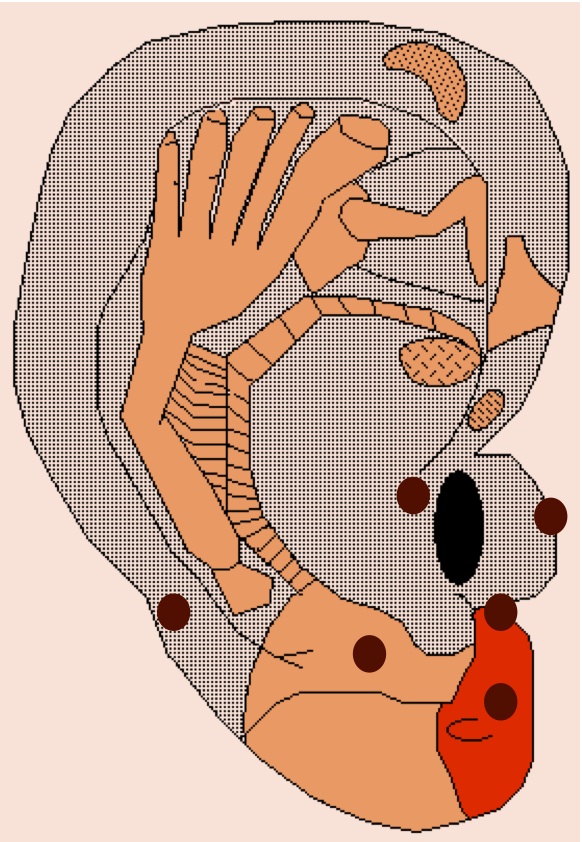Explanation of Conventional Notations
WHO Points (OMS in French, standing for Organisation Mondiale de la Santé)
For the World Health Organisation points, the official report suggests that AM (MA in French) should be added in front of the consensual locations. It stands for auricular microsystem (microsystème auriculaire). Although this terminology seems pointless to us, we have chosen to respect it because of certain comments that have been made.
Sectogram
Yves Rouxeville has suggested combining the sector number with the WHO designation. For example, MA-SF 10-11-12 for the shoulder point.
We have sometimes added
"p" if the point is posterior.
Nogier’s Zone
We have retained the zones as defined by Paul Nogier in "auricular reflex points". The number which follows is that which corresponds to the main point on the zone (red square), but it applies to all the points on the zone.
The numbering is that corresponding to the pages for the auricular reflex points or to those for the additions to the auricular reflex points in the case of those not figuring in the first edition.
Bahr/Wojak Numbering
The numbering is that of the points on the grid, but it does not always correspond with the name of the organ in Nogier’s points. The points corresponding to the organs according to Bahr are therefore indicated on other points, the list of which can be found here
Chinese Nomenclature
CN = Chinese nomenclature, according to the standardised Chinese coding 1992-2008 (G B/T13734-1992)
The other nomenclatures
Oleson, Alimi, Chinese points
are not all listed. It will be done as we go along.
The Aims of the Site
The site has been designed to present the different naming systems being used in auriculotherapy. The aim is to make the existing data available to practitioners and specifically to enable them to find their way through the maze of published articles.
It is a personal piece of work, intended as a work tool and wishing to remain independent of the various schools of thought. Everyone is invited to take part.
We shall try to present all the contributions objectively, without any foregone conclusions.
If we have chosen the Bahr/Wojak grid as a work base, it is because it was the easiest data processing tool to set up. It also has the advantage of showing the details very clearly.
An index card will be associated with each point, describing the different nomenclatures and the bibliographical references that we have found.
It will require several years work and you are all invited to help me by sending me the references and protocols that you use.
There is a surprising variety of points. We will try to explain why in another article. It is all very confusing for the practitioner.
What we are fighting for:
We would like there to be an international agreement about the location of points, without reference to the names of organs or their functions. The clinical or organ correspondences could then be described by each practitioner in his/her publications.
However, the most important thing is to be able to locate the point in use to a specific zone on the ear, whichever technique or nomenclature is being used.
 Points d’auriculothérapie / Auriculotherapy Points
Cartographie synthétique et évolutive
Points d’auriculothérapie / Auriculotherapy Points
Cartographie synthétique et évolutive
